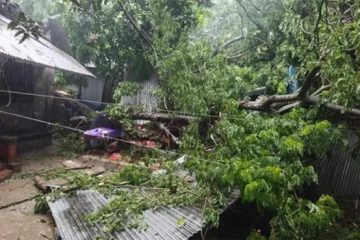People in rural areas are far away from getting the minimum health care although the country has one of the world’s best public health infrastructure spread down to villages.
All successive governments thought afresh of public health and built some structures spending public money only for them to become redundant during the tenure of the next government.
Several hundred community clinics resumed activities after remaining unused for more than seven years and many buildings lost relevance with the change of government and shift in focuses. Appointed doctors stay away from union health centres while upazila health complexes run without adequate doctors and logistics.
Ambulances and X-ray machines often go out of order and in most cases they are never repaired, giving business to private sector.
New Age correspondents from outside Dhaka portray the sorry state of the rural healthcare system.
The previous Awami League government built 10,700 community clinics between 1998 and 2001, each at a cost of Tk 5 lakh on land donated by local community. A medical assistant and a family welfare assistant were supposed to be posted in each CC to meet primary healthcare needs of rural people.
The government ended its tenure in 2001 and the structures remained unused since then.
These abandoned one-storey concrete buildings got a fresh lease of life with the return of the Awami League-led alliance government, health officials said. An initial survey found some 8,000 of CCs operational.
There are about 1400 union sub-centres and family planning centres, which are also marred by absence of doctors and unavailability of medicines.
The New Age correspondent in Tangail reports the district civil surgeon office has reopened 362 CCs in 12 upazilas.
Tangail civil surgeon Dr Sudhir Chandra Bhoumik told New Age that the department concerned has started repairing the CCs. ‘All the CCs will start activities in full swing soon. They will get required staff,’ he said.
Half of the district’s 106 union sub-centres do not have the infrastructures yet and their staff members are posted in upazila or district hospitals. Rural people remained as deprived as they were.
Each USC is supposed to have one medical officer (MBBS), one medical assistant, one pharmacist and one MLSS to give outpatient services.
Al-Amin Miah of Fatehpur village of Dhaynna union of Sadar upazila said, ‘We do not find any doctor when we go to the union health centre. We sometimes see the MA, who suggests us to go to clinics in the town for better treatment.’
Zakir Hossain, medical assistant of Hugra sub-centre who is now working at Tangail General Hospital, said, ‘We have not got any office building there.’
The Kurigram correspondent reports, eight x-ray machines out of 11 at Kurigram Sadar Hospital, TB clinic and upazila hospitals are out of order. Besides, five ambulances, six generators, five auto clove machines, five sterilizers and 13 oxygen cylinders are dysfunctional, Kurigram Civil Surgeon office sources said.
The TB clinic, where x-ray is a must, is running without an x-ray machine, sending patients to private diagnostic centres.
The district has got only 857 staff members against 1,284 sanctioned posts for doctors and health employees.
District civil surgeon Dr Toufikul Islam said they informed the director (primary healthcare) of health department recently of all problems relating to manpower and logistics.
Healthcare service in public hospitals in Rangpur is no better and constraints are more or less the same as in other districts, reports the New Age correspondent.
Closure of the district’s old 100-bed general hospital has put extra pressure on Rangpur Medical College Hospital. Local people and the civic groups have long been demanding reopening of the old hospital with improved facilities and increasing the number of beds at RMCH to 1000 from 600 now.
RMCH Director Dr Kazi Shahadat Hossain said, ‘We have to face troubles as the number of patients is more than double our beds.’
The Sylhet correspondent reports, 568 out of a total 889 community clinics in Sylhet, Sunamganj, Moulvibazar and Habiganj districts under the division were made functional from April 1 this year, says Nimai Chandra Mandal, director at the Sylhet divisional health office.
Baratola Community Clinic at Alankari union under Bishwanath upazila and Baldi Community Clinic at Tetli union under Dakshin Surma upazila were seen closed during work hours on July 15 with none of the concerned health workers present.
Ali Hosen, who lives adjacent to the Baldi Community Clinic, told New Age that two employees were appointed to run the clinic. ‘But they remain absent on most of the working days,’ he added.
Similarly, the union health centres in the regions are also facing shortage of staff and necessary medicines.
Nasrin Sultana, sub-assistant community medical officer of the Alangkari Union Health and Family Welfare Centre, said, ‘A medical officer was appointed last year. But he never had come here and later he managed a transfer to Dhaka in two months.’
‘Number of visitors at the centre is declining every day as we cannot offer them even the common analgesic tablet like paracetamol,’ Sultana said.
Abdur Rahim, 55, of village Burunga under Balaganj upazila in the district complained the medical officer of Burunga Union Health Centre, Dr Taufiq Elahi, hardly comes to the centre.
‘The doctor remains busy with his private chamber at a bazar of the upazila,’ he said.
Dr Taufiq Elahi said he never sees patients at his private chamber during duty hours.
M Fayez Ahmed, civil surgeon in Sylhet district, told New Age that they have a plan to computerise the rural healthcare centres within the current financial year to ensure better monitoring of rural healthcare services.
Reports from Rajshahi said out of 2,031 community clinics in Rajshahi district, 170 have been reopened with limited manpower and medicines.
The condition of the CC in a village of Kolma union under Tanore Upazila is so shabby that people fear to go inside the centre once in a month just for vaccinating their babies. Locals visit Sajuria, Majgram and Bhatkhali CCs under Bagmara and Pachandar in Tanore upazila only omce in a month for immunizing babies.
Upazila health complexes are also handicapped with shortage of doctors, nurses, staffers and necessary logistic supports.
Civil surgeon office said more than 60 per cent of the approved posts for physicians, about 39 per cent of the posts for class III employees and over 45 per cent of the posts of class IV employees at upazila hospitals and health complexes have been vacant for years.
Only 95 physicians and assistant physicians are working now in the nine upazila hospitals and health complexes, which have 230 approved posts for doctors.
‘We cannot run X-ray machine for over a year for technical complication’, said Amanullah Chowdhury, Bagmara Upazila health and family planning officer.
Ambulances remain inoperative most of the time, said an upazila health official of Puthia.
Mahrram Ali said he did not get medicine for fever for his three-year son at Mohanpur Upazila Health.
Abul Fazal, the district deputy civil surgeon, said they have requested the higher authorities to solve the shortage of doctors and other staff members.
There are 32,521 vacant posts at different departments of the health and population sector, according to a health ministry official.
Prime minister Sheikh Hasina last month approved the plan to appoint doctors and health service employees against 28,056 vacant posts. Earlier, she announced ad hoc appointment of 4000 doctors.
Health secretary Sheikh Altaf Ali told New Age on August 1 that the government has taken an initiative to appoint 4,000 physicians and necessary staff members.
Asked about the government’s steps to ensure doctors’ presence at village health centres, the secretary said they will keep the matter in consideration while filling in the vacant posts.
He said the government has also started replacing the ambulances and health equipment, including X-ray machines, which had remained out of order for years at the upazila and district hospitals with new ones.
Steps have also been taken to repair the vehicles and health equipment at the earliest, he said, adding ‘It is a continuous process’.




















